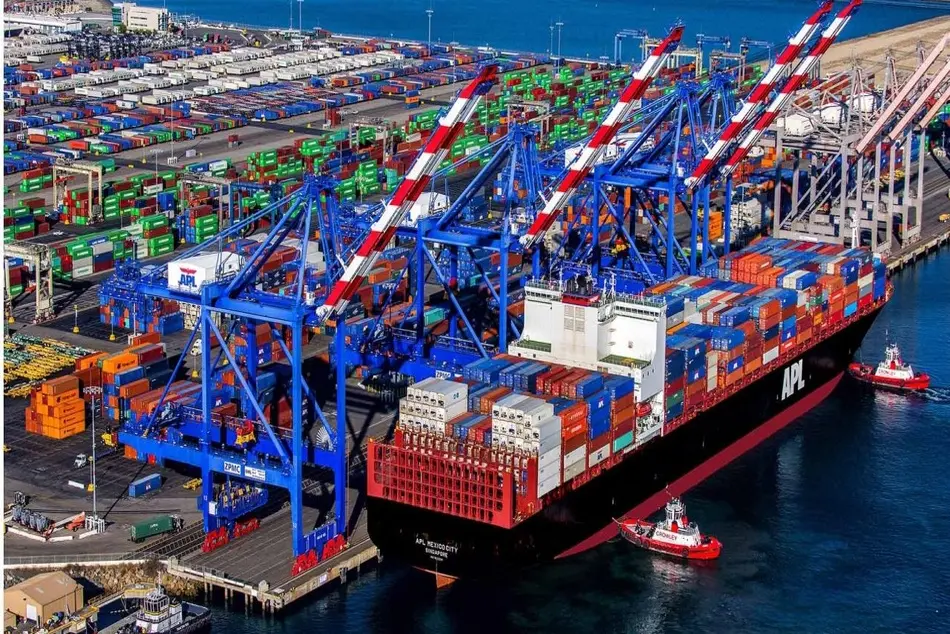Port of LA already meets 2023 emission targets
Port of Los Angeles has seen an unprecedented 60% drop in nitrogen oxides (NOx) emissions compared to 2005, their lowest level to date, according to the Port’s 2017 Inventory of Air Emissions released last week. The inventory also shows the Port container volume reached an all-time high of 9.34 million TEUs through 2017.

Port of Los Angeles has seen an unprecedented 60% drop in nitrogen oxides (NOx) emissions compared to 2005, their lowest level to date, according to the Port’s 2017 Inventory of Air Emissions released last week. The inventory also shows the Port container volume reached an all-time high of 9.34 million TEUs through 2017.
"Overall, the 2017 findings show the Port has maintained or exceeded the dramatic clean air progress it has made over the last 12 years, and has now met all of its 2023 Clean Air Action Plan (CAAP) goals. Diesel particulate matter (DPM) remains down 87%, and sulfur oxides (SOx) remain down 98%."
To reduce emissions while also increasing cargo volumes, the port had to reduce the average amount of emissions it generates to move each container. Using this type of measurement, the Port also lowered the average amount of emissions the port generates to move each container of cargo for all eight pollutants tracked by the Port’s emissions inventory, including greenhouse gases (GHG), which were down 30% per container on average since 2005.

Highlights
- Based solely on tonnage, GHGs are down only 13%, which is a result of the substantial increase in activity in 2017 leading to the record cargo volumes. The Port’s best year for reducing tons of GHGs was 2013 when GHG emissions were down 23%, a year when TEU volume was still down from its pre-recession peak.
- Larger ships carrying more TEUs played a key role in preserving the Port’s clean air gains. Container ship calls were down 22% while the average number of TEUs per vessel increased 60% since 2005. Fewer ship calls also led to fewer harbor craft trips.
- The largest ships tend to be new-builds with cleaner engines, another contributor to clean air gains reported in 2017. Additionally, in compliance with California’s progressively stricter shore power requirements, more ships plugged into shore-side electricity instead of burning fuel at berth. Ships that cannot plug in increasingly used alternative technology to capture emissions at berth.
- Effective 2017, all ships calling at the Port met California and North American Emissions Control Area requirements to use fuel with 0.1% or lower sulfur content. More ships also are reducing fuel consumption by slowing down within 40 nautical miles of the Port.
- Ongoing turnover of the truck fleet and upgrades of cargo handling equipment with the cleanest available engines also helped hold the line on emissions. More than half of nearly 17,000 drayage trucks calling at the Port in 2017 have 2010 model year or newer engines. Nearly 47% of cargo handling equipment – including cranes, tractors and forklifts – have Tier 4 or equivalent diesel engines, the cleanest diesel emission technology on the market.
The Port of Los Angeles is America's premier port and North America’s leading seaport by container volume and cargo value, that facilitated $284 billion in trade during 2017.
As container throughput increases, the Port is working to implement more aggressive strategies to maintain its clean air gains and continue to meet the 2023 goals.
New in the 2017 Clean Air Action Plan (CAAP) Update are targets for reducing GHG emissions: 40% below 1990 levels by 2030 and 80% below 1990 levels by 2050. Strategies for reaching these targets include transitioning the on-road drayage fleet serving the Port to zero-emissions trucks by 2035 and all terminal equipment to zero emissions by 2030. Improving operational efficiencies, deploying advanced technology and managing energy resources are essential to this progress.
Near-term measures for accelerating clean air progress include requiring all trucks entering Port service for the first time to meet 2014 model engine emissions standards.
To advance long-term goals, the Port is working with private and public sector partners to test more zero emissions drayage trucks and demonstrate near-zero and zero emissions cargo handling equipment.



